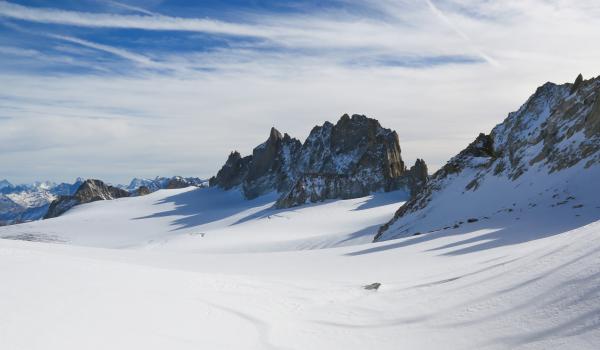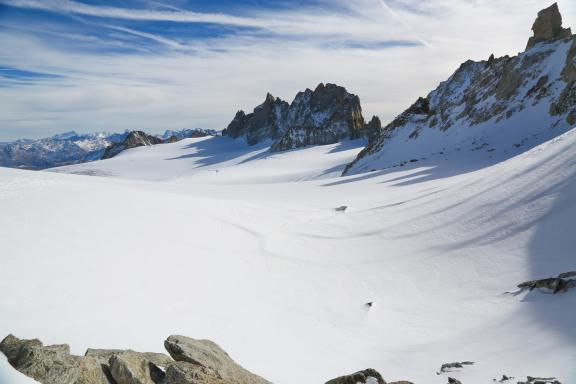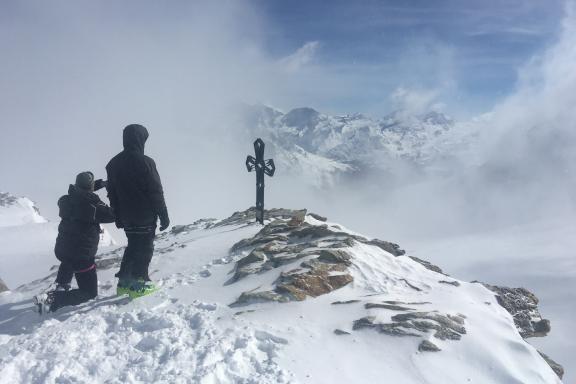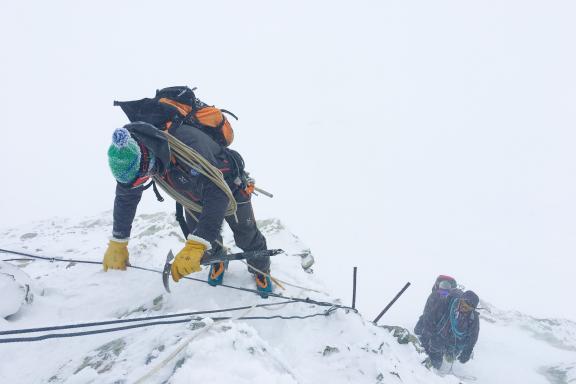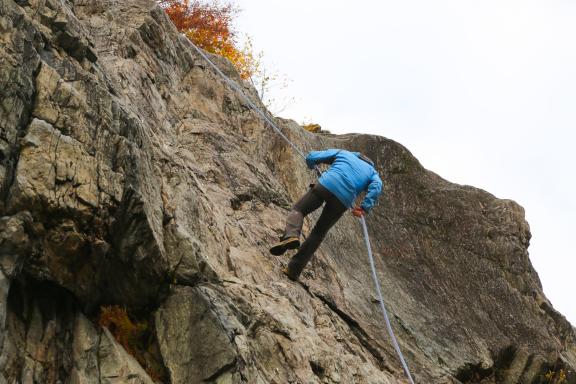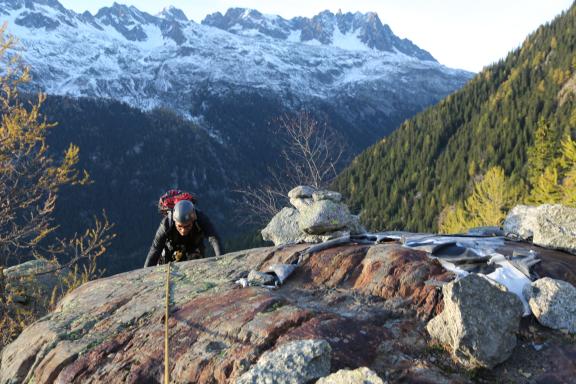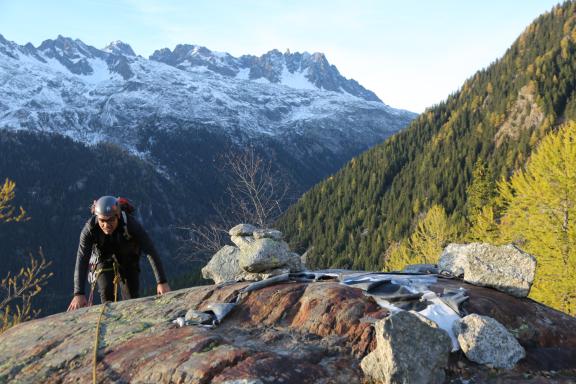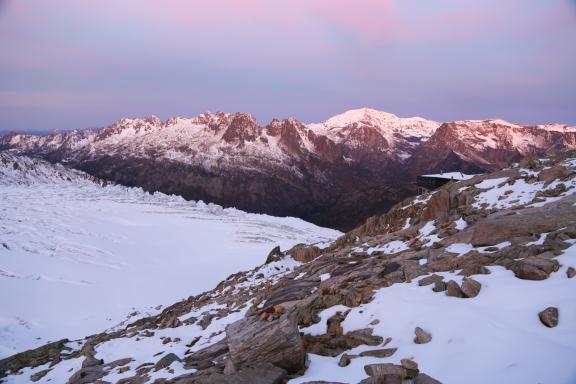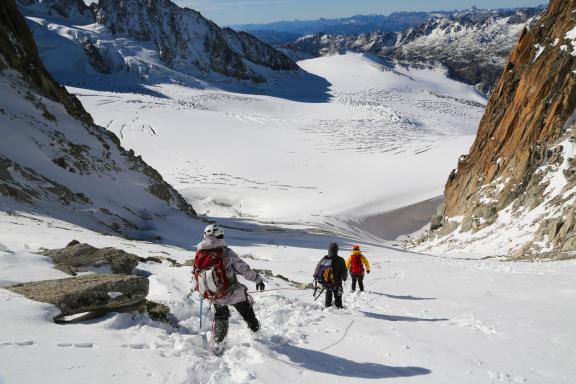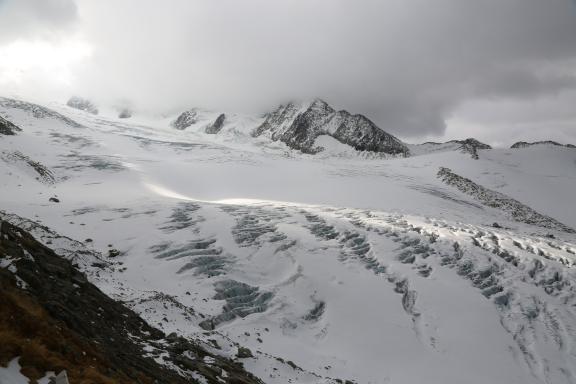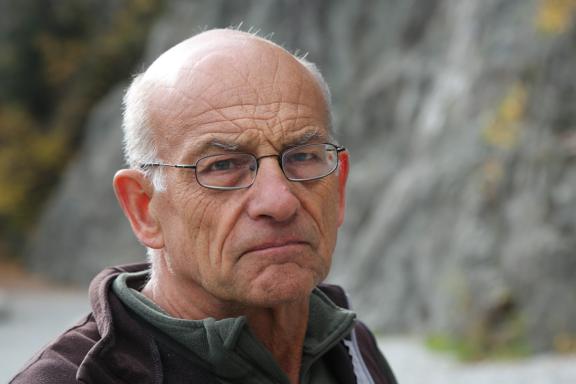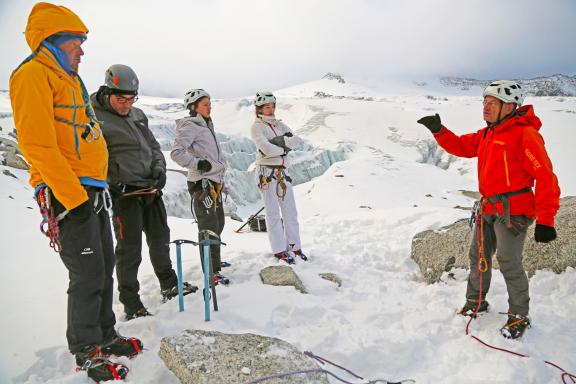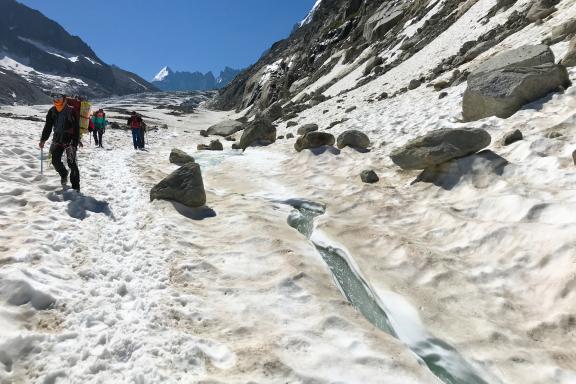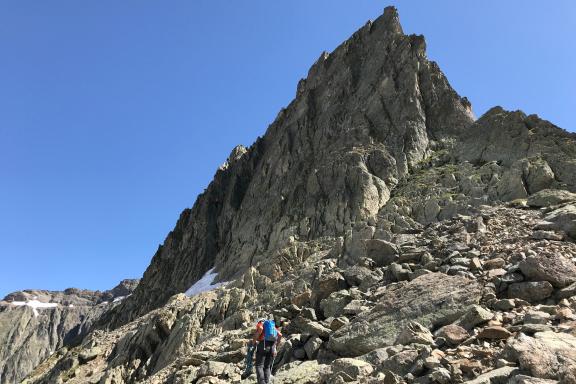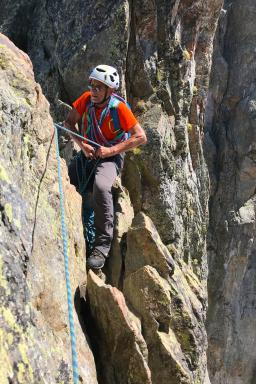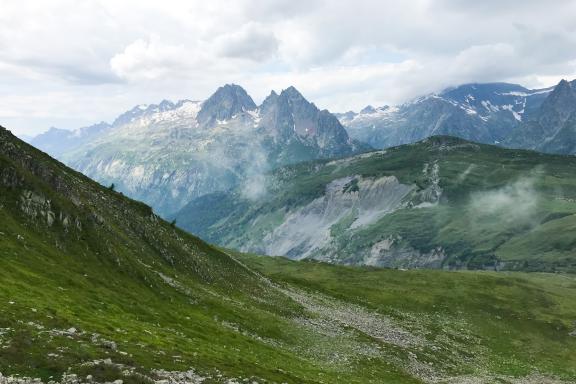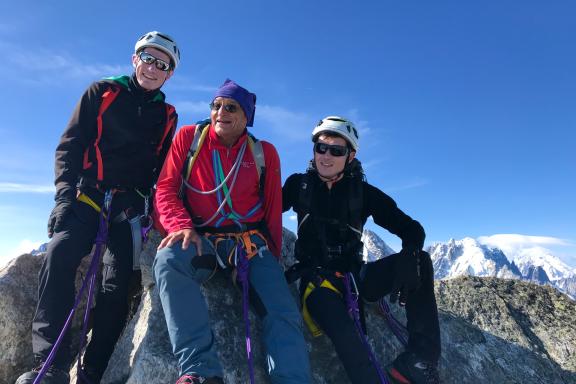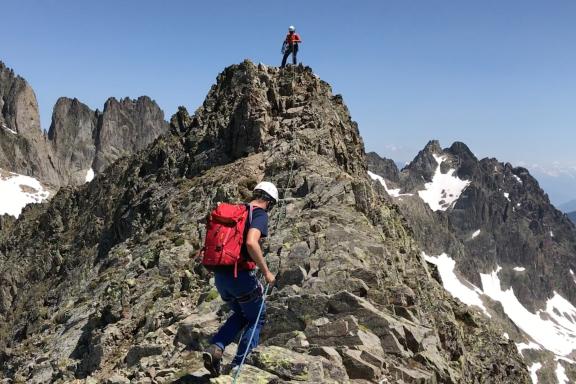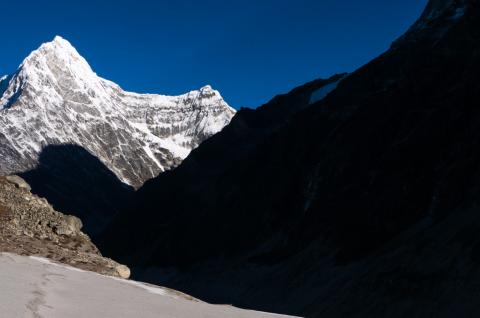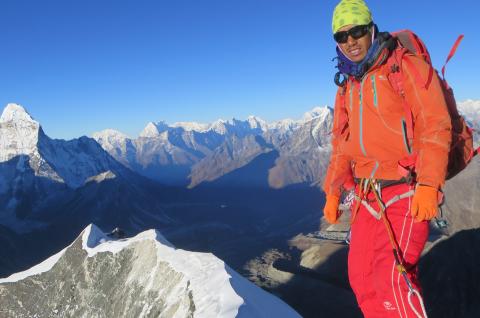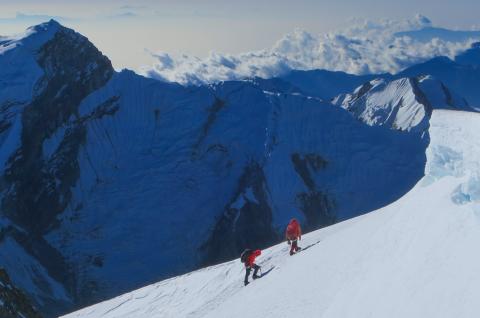An operational mountaineering course to immerse yourself and make progress
Highlights
- Course led by Bernard Muller, one of France's most renowned mountain guides.
- Acquisition of mountaineering and high-mountains for greater autonomy
- Practical course with ascent of the Aiguille du Tour at 3540 meters
- Accommodation in single rooms in hotels
Led by Bernard Muller, this course provides an introduction to climbing techniques in glacial and rocky environments. We review the use of all our equipment, and look at belaying the leader and second of the roped party, applying protection, abseiling on ropes, and more. We take a closer look at risk assessment, safety and crevasse rescue. The program covers five days of increasing technical difficulty. To conclude our training, we climb the Aiguille du Tour or the Tête Blanche. Throughout the course, Bernard talks to us about his countless climbs and shares his expert guide tips. A course that immerses us in mountaineering and the high mountains... so that our first steps lead us to our most beautiful ascents!
Itinerary
Day 0
Mountains are an incredible but demanding environment, so our introductory mountaineering course enables us to learn how to progress confidently in an alpine setting and discover these foreign landscapes. Throughout the course, and during your evenings in particular, we focus on the essential elements needed to prepare for a successful expedition:
- survival in a hostile mountain environment;
- crevasse rescue: self-rescue, hauling techniques, etc.
- pack preparation: mountaineering clothing, equipment, organization, etc.
- orientation: topographical preparation and map reading, use of GPS, preparation of walking angles, etc.
Early this morning, Bernard presents us with the program for our next five days.
Day 1: Equipment and rock school
Day 1
We start with our leader by a rock school, practising first at our accommodation and then quickly on an outdoor wall (Les Gaillands climbing site or others).
Once there, we visualize the climbing equipment needed to ensure a safe ascent:
- ropes, the central element of mountaineering: tie-down ropes, double and twin ropes, etc.;
- belts, cords, carabiners and quickdraws, harnesses, etc.;
- climbing boots and shoes (their rigidity and weight according to the difficulty of the terrain);
- belay devices, stoppers and positioning for optimum hold.
Bernard introduces us to the use of ropes. We take time to learn about the importance of roping and knots: knots, abseil ropes, belaying and self-belaying at belay stations, etc. We learn how to set protection points, belay, set up belays and use harnesses.
At the same time as Bernard introduces us to progression techniques, we learn how to abseil, and thus how to progress "length by length" in the opposite direction. We take a closer look at setting up the rope, using cords and self-belaying, and so on.
Day 2: Rock school and via corda progression
Day 2
As practice progresses, we feel more confident in rocky environments. To complete our rock climbing training, we devote our next day to progression techniques in a vertical environment, a beautiful via corda where we can test our technique and vertical progression over several pitches. A magnificent environment and an exciting exercise!
Once on the site, we spend our time learning about progression and belaying techniques:
- roped progression and belaying on the move: simple, fast maneuvers that require a great deal of practice. We work on the leader's role, which is essential for moving with ease and stability in high-altitude situations.
- length-by-length progression: this technique is adapted to difficult terrain where there is a risk of falling.
We work alongside our guide to learn how the first and second climbers should be positioned, and how far they should be roped up, depending on the difficulty of the terrain.
Day 3: Crevasse safety and rescue
Day 3
We take advantage of our guide's experience to spend the day learning about crevasse safety and rescue. Depending on the time of year and the weather, we climb the Argentière glacier, the Mer de Glaces or the Tour glacier.
For practical reasons, we can also carry out these exercises in a non-glacier area, which may be less of a change of scenery, but are highly beneficial in terms of technical learning. Your supervisor makes the decision that best suits your experience. In particular, you review :
- self-rescue: getting out of a crevasse on your own;
- reeving techniques: making a mooring line, installing a self-locking device, etc.
We return to the inn.
Day 4: Training climb – Ascent to the refuge
Day 4
This morning, we set off for a two-day ascent of a beautiful summit, the Aiguille du Tour, Tête Blanche or Pointe Lachenal... Our guide decides which summit to take, depending on a number of factors, including the weather, the terrain and the general level of the group. These summits offer an easy introduction to mountaineering. In fact, these are accessible climbs in the high mountains, in exceptionally rich Alpine landscapes.
Most of the time, our preferred option is the Aiguille du Tour or Tête Blanche, with an overnight stay at the Albert Premier refuge.
During the summer, from June to September, the refuge is guarded and we enjoy its comfort! We use the cable cars, and our altitude difference will be some 500 meters.
From All Saints' Day onwards, the refuge is unguarded and we have the chance to live in total autonomy. Our ascent is made without a lift, and we climb 1200 meters!
During the day, once at the refuge, we get out and Bernard teaches us how to evolve on the glacier, with the possibility of a few ice school abseils, depending on the time we have available. We deepen our knowledge of anchoring: how to fit a pin, how to set up a belay and how to make a lunula.
At the end of the day, we take the time to live in the refuge, allowing time for an essential element: food. Naturally, this must be taken into account when anticipating physical effort, which depends on the degree of the slope, the nature of the ground, the weight of the rucksack, the difference in altitude, and so on.
Day 5: Training climb – summit ascent
Day 5
After waking up early on one of Mont-Blanc's most beautiful glaciers, we set off with our ice axes and equipment to explore the summits, probably the Aiguille du Tour and Tête Blanche. With Bernard, we review the elements we covered on the first few days: belaying, roped walking and progression techniques.
Based on the climbs he has completed, Bernard shows us how to optimize our energy output according to the level of difficulty of the climb, the speed of progress, the frequency of breaks and protection against the cold.
Bernard teaches us glacier progression techniques to improve our balance and movement:
- anchoring: how to obtain a solid anchor using your ice axe;
- cramponing, which varies according to the quality of the terrain: flat-footed (getting as many spikes as possible into the ice), mixed cramponing (one foot flat and the other on the front spikes), frontal cramponing (only the front spikes are anchored in the ice).
A day that rounded off our training course under the guidance of an enthusiast!
We return to the valley at around 5:30 p.m., or at a time agreed by all participants.
END OF EXPEDITION
For reasons that cannot be foreseen at this stage, such as unpredictable weather, the physical fitness or lack of fitness of participants or other circumstancess (customs formalities, road conditions, traffic, landslides, force majeure, etc.), your expedition leader may have to adapt the program, if necessary, to ensure the smooth running of your trip. He remains the sole judge and the one who guarantees your safety. Activity times are given as an indication and may vary from one participant to another.
The itinerary for all our expedition programs, or the ascent program for our high-mountain expeditions, are given here as a guide only. They are flexible enough to adapt to weather conditions with a few contingency days. In any case, you should follow the recommendations of your guide, who may suggest that you cancel your expedition due to weather, safety or physical conditions.
It is important to remember that this is a truly unsupported expedition, and that anything can happen. Expeditions Unlimited, your expedition leader, your guide or our local teams can in no way be held responsible.
Any costs incurred as a result of a change in the expedition schedule (extra nights' accommodation, extra flights) will be borne by the participants and not by the organizers. "Contingency days" refer to the expedition in the strict sense of the term (base camp/base camp in the mountains, departure point/exit point on a traverse, etc.).
Any early return of the expedition or of certain members only (early success, abandonment, etc.), generating costs for accommodation, meals, changes to air tickets or other activities not provided for in this program, will be charged in full to the participants.
Trip notes
Guiding
Your guide on this climb is usually Bernard Muller, one of the world's most experienced guides - see description above. On certain dates, however, and depending on the size of the group, another experienced guide may be appointed, who will be specified when you register.
Your guide will adapt the content of the course according to the technical and physical qualities of the participants, their current state of fitness and the weather. He makes all decisions necessary to ensure the course runs smoothly. His authority is paramount and inescapable. You must respect his decisions, as well as those taken collectively.
If, for reasons beyond our control and duly justified, your designated guide is unable to ensure your stay, he or she will be replaced by another experienced French mountain guide. The services would not be modified, the conditions of the stay would be identical and this change would not constitute a valid reason for cancellation.
Furthermore, we are always dependent on mountain weather conditions. A few days before departure or during your stay, your guide may have to modify the program for your safety. The alternative route (Monte Rosa, Grand Paradis, etc.) would then be determined with your guide and the other participants. The services would not be modified, the conditions of the stay would be identical and this change would not constitute a valid reason for cancellation.
For unpredictable reasons at this stage, like adverse weather conditions, insufficient physical condition of participants, insufficient competencies of participants related to the intended activities, your guide may decide to adjust the intended program and/or activities. At all times, his decision will be final on all matters likely to affect the safety and well-being of the trip.
Difficulty level
Level rated: challenging
This program is designed for participants who take part in a regular sports activity several times a week, including endurance activity.
This program is designed for participants who take part in a regular sports activity several times a week, including endurance activity.
Guides are increasingly reluctant to supervise under-age climbers on challenging alpine ascents for reasons of responsibility, especially if they don't know the participant's level. To find out more, don't hesitate to ask us if one of the members of your group is a teenager, and together we'll assess the feasibility of the project according to his or her experience.
Technical difficulty
Mountaineering level: F like... Easy (Facile in French!)
In this program, the use of mountaineering equipment (crampons, harness, ice ax, ropes, etc.) is necessary but the route covered does not involve any technical difficulty. It is therefore aimed at beginners or even participants who have never practiced. Clearly, a little prior experience in the activity can be interesting, knowing how to equip yourself, knowing how to tie a few essential knots. The mountaineering courses at our Adventure School from three days are for you. And this technical rating applies of course to normal weather conditions: the difficulty can increase in the event of bad weather conditions, fresh snow on rocks, insufficient or lack of quality of the ice, etc. Likewise, the situation changes radically, for the same technical level, with the altitude, the weight of the bag, the lack of equipment on the route, the fatigue associated with the approach if it is long, the environment if particularly hostile, etc.
Meeting point
Meet up directly at the course venue from 9 a.m. at Les Houches station (Chamonix valley).
Given the diverse origins of the participants on this trip, international outward and return flights are not included in this package. In most cases, we book flights on your behalf to ensure that the whole group arrives at the destination at the same time. We do not charge any fees for these air bookings. Please do not hesitate to contact us. If you book your own tickets, we will advise you on the ideal flight schedule to enable all participants to arrive within a reduced time frame. At the very least, you need tickets that can be modified.
Accommodations
Accommodation in a single room in a hotel and at the Albert 1er refuge in a shared room for 8 people.
Meals
Half-board: breakfast and dinner are taken at the gîte (mountain lodge). Lunches are in the form of picnics and are paid for out of a common fund to which you contribute on arrival: 75 euros for the whole stay.
Transfers / Transport
No transfers are provided. Participants' own vehicles can be used to get to nearby activity sites according to the program. We can also arrange for participants to share a car.
Group size
The group is composed of 3 to 4 participants maximum. The number of participants is deliberately limited to allow for greater immersion, to avoid embarrassing our hosts, and to develop freedom and flexibility. However, the maximum number may be exceeded if the last person to register wishes to travel with one or more other people. The services will not be modified, and the conditions of the trip will remain the same.
Equipment
Personal equipment is not provided. However, a complete list is provided to allow you to check that you are taking what is necessary.
Our commitments to sustainable development
Our commitment to a better planet has been a reality since the beginning of our story but we always need to do more and better. Please find out more about our charter and our commitments in terms of sustainable development. We have drafted our charter and take action through six themes on which we act as concretely as possible, most often with you: social equity and cultural respect, preservation of water, waste management in expedition, protection of biodiversity, raise public awareness on these subjects and finally, the optimization and recovery of CO2 emissions.
Regarding carbon emissions, most of which are due to air travel, we calculated and communicated in 2018 on the carbon footprint of each of our programs, expressed in tonnes of CO2.
These calculations made us aware of the importance of the total carbon emissions generated by our activity. Also, we have committed in 2022 to a carbon reduction that we believe is unprecedented in the tourism industry, aiming to reduce the total emissions of our activity by 5% per year, taking 2019 as the reference year (3,430 tonnes of CO2). This commitment is in line with the trajectory of the Paris climate agreements of 2015, the current benchmark. Thus, in 2030, we commit ourselves not to exceed 2,160 tonnes of C02. Thus, our maximum “carbon” budget for 2024 is 2,950 tonnes and for 2025, this budget will be reduced to 2,800 tonnes. And so on until 2030. To find out more about all of our calculations and our commitments in terms of reducing our carbon emissions.
In addition, since 2019, we have been encouraging you when you book for your journey to contribute with a donation to an independent NGO, among the two we have selected that share the commitments made in our charter. We matched the amount of this donation to this program's carbon footprint. Thus, the journey you are considering generates 0,08 tons of CO2, which corresponds to a 100% donation of €2 for an estimated value today of €30 per tonne of CO2. This donation remains of course optional and you can decide to give between nothing and 100% of this amount. Since 2019, including covid years of 2020 and 2021, we have been able to collect thanks to you nearly €7,000 for these associations.
Please do not hesitate to come back to us with any questions you might have regarding this carbon footprint mechanism, our other sustainable développement commitments or even to share with us your experience through a chat or a mail at contact@secret-planet.com.
Bernard Muller, mountain guide
Alsatian by birth, Bernard Muller discovered mountaineering during his teen years.
It is in the late 70s that he begins long expeditions. In 1979 he led an expedition to the summit of Nanga Parbat (8125 m). In the purest alpine style, he then continued other 8000-meter peaks: the South of Dhaulagiri (8167 m) in 1980 and the West face of Manaslu (8163 m) in 1980. Two major successes. Over the following years, Bernard accomplished the South face of Aconcagua (the highest peak in Latin America 6962 m) and a world first without oxygen on the Southeast corridor of Kangchenjunga (8505 m).
Several times he led expeditions to the summits of Gasherbrum II (8035 m), Everest (8848 m), Cho Oyu (8201 m), Shishapangma (8027 m). Bernard then explored the polar lands and succeeded twice in the crossings of Greenland (1997 and 1998), Iceland (1999) and Baffin Island (2000). In short, he is one of the most experienced guides in the world.
Bernard has the expertise to optimize the chances of success of this expedition, in both management rate and group progression, key elements in this type of expedition.
Departures and pricing
Please find below all dates and prices for this expedition. Prices are quoted "from" and may be adjusted notably according to the number of participants (see trip notes for details). Please note that dates and prices for years beyond 2024, when given, are for guidance only and are subject to change and readjustment to take account of current economic realities.
No date works for me!
I initiate a new datePrice includes
- 3/4-star (***) hotel accommodation in Chamonix with breakfast, single room, for three nights
- Transfers by private vehicle between activity sites
- Meals as mentioned in the day-by-day program description
- Hotel accommodation in single rooms
- Mountain refuge accommodation in shared rooms and dormitories
- 1 experienced mountain guide
- Collective equipment required for the program (fixed ropes, mooring devices)
- Cable carts and mountain lifts if used
- Climbing taxes and permits, government environmental taxes
Price does not include
- Transport to meeting point on first day
- Any additional hotel nights in Chamonix (over 1 night)
- Any transfers not mentioned in the day-by-day program description
- Meals other than those mentioned in the day-by-day program description
- Expenses related to the early return of the expedition or of certain members only (early success, abandonment, etc.), generating costs for accommodation, meals, changes to air tickets or other activities not provided for in this program
- Expenses related to a shift in the expedition schedule (extra nights' accommodation and meals, additional airfares)
- Tips for your mountain guide
- Personal equipment, including individual mountaineering gear
- Rental of personal equipment, subject to availability (ask us)
- Drinks and personal expenses (sightseeing, cabs, souvenirs, dry cleaning, etc.)
- Travel and expedition insurance (assistance, evacuation and repatriation)
